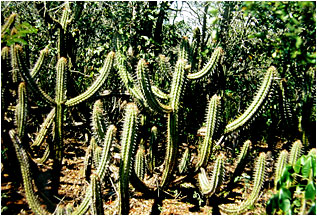 Caatinga (photo CE) |
CAATINGA
SCRUB ZONE
|
| Placed
between the Amazon Forest and Atlantic Forest, formed by part of the states
of Alagoas, Bahia, Ceará, Maranhão, Paraíba, Pernambuco, Piauí, Rio Grande
do Norte, Sergipe, northeast of Minas Gerais, there is a very dry region
with a semi-arid climate where the course of waters just exist because of
the rains. There are two hot seasons which are not very well defined: a
dry one and a rainy one (winter). The vegetation occurring there is called
"Caatinga" and covers at 10% of the Brazilian territory. It is very a characteristic vegetation with scrub and herbaceous formation, small thorny leaves and irregular occupation, presenting areas similar to a wood and some other presenting almost naked ground. But for the borders of the river , the caatinga strictly speaking is really very poor in orchids. |
 Catasetum barbatum (foto: SA) |
The
presence of Epidendrum ciliare (in the state Ceará), Catasetum purum, barbatum,
Oeceoclades maculata (PE), Oncidium cebolleta, Brassavola sp. are confirmed
in this ecosystem. (Augusto Burle Gomes Ferreira - Orchid Survey of the Eastern Brazilian Northeast). In this place, they grow very protect from the sun, in general |
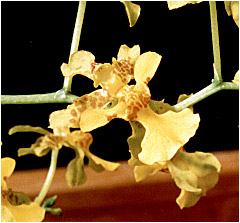 Oncidium cebolleta (foto: SA) |
|
in the low branches of the shrubs. However, placed inside in this semi-arid
region, there is an ecosystem that, in northeast, is called Swamps
of altitude. In fact, this is a Montane Tropical Rainforest. In
the area of the coastal plain (which move forward the interior for 40km),
there is a plateau at about 400m altitude where are settled down ranges
of mountains or isolate mountains which height varying from 800 to 1.000m
altitude. During the day, the clouds raise and stay high over those mountains
while the night, they lower, stop and completely surround the mountains.
Therefore, the vegetation is moistened by the fog and when the day comes
and the sun shines, as it is placed in semi-arid region, everything dries
out, but not completely. A certain humidity remains. And the swamps
of altitude are found in those mountains, true suspend oasis. In spite
of the name adopted (swamp), the ground is not swampy although very wet.
|
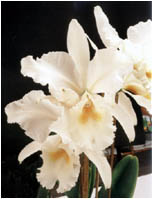 Cattleya labiata angerei (foto: SA) |
Cattleya
labiata just occurs in this ecosystem (since 400m altitude). Around
14 varieties of color of this species have been described: alba, alba-plena,
coerulea, concolor, flamea, lilás, pérola, rosada, rubra, semialba, semi-concolor,
suave, vinicolor and peloric, besides the distincion of the lip (ametistina,
ardósia, coerulens, violeta, amoena, solferina) and pattern of the lip
(anelato, atro, estriato, integro, marginato, oculato, orlato, punctacto,
venoso, venoso estriado). Cattleya
granulosa also occurs in the plain as well in the swamps of altitude. |
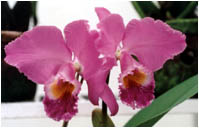 Cattleya labiata suspensorio (foto:SA) |
| Species
of this ecosystem: Aspasia variegata, Brassavola tuberculata, Bulbophyllum sanderianum, Camplocentrum selowii, Catasetum barbatum discolor hookeri,, macrocarpum, purum, uncatum, Cattleya granulosa, Cattleya elongata , Cattleya labiata, Cattleya x le czar, Cochleanthes flabeliformis, Coryanthes speciosa, |
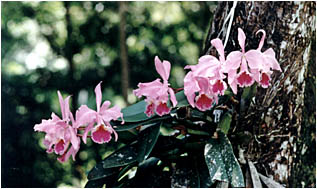 Cattleya labiata autumnalis (photo:SA) |
Cyclopogon bicolor, congestus, Cyrtopodium polyphillum, aliciae, gigas, Dichaea cogniauxiana, Dimerandra emarginata, Dipteranthus duchii, Epidendrum armeniacum, avicula, cinnabarinum, fulgens, schomburgkii, denticulatum, nocturnum Encyclia acuta, euosma, longifolia,oncidioides osmantha, patens, Gomesa recurva, Gongora quinquenervis,Ionopsis utricularioides, Isochilus linearis, Liparis nervosa, Masdevallia infracta, Maxillaria amazonica, desvauxiana, |
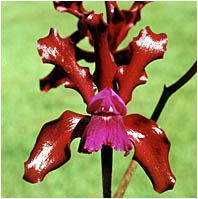 Cattleya elongata (photo:SA) |
Miltonia flavescens, Miltonia spectabilis var. moreliana, Notylia barkeri, microchila, Octomeria oxichela, linearifolia,, Oeceoclades maculata, Oncidium cebolleta, raniferum, ciliatum, phymatochilum, gravesianum, Phragmipedium sargentianum, Phymatidium delicatum, Pleurothallis rudolfi, trifida, saudersiana, Prescottia stachyodes, plantaginea, Prostechea, alagoense, fragrans, pygmea, vespa,Rodriguezia bahiensis, bracteata,Sarcoglottis grandiflora, Sacoila lanceolata, Schomburgkia crispa, moyabambae, Sobralia liliastrum, Trichocentrum albo-coccineum, fuscum, Trigonidium acuminatum, Trichopilia santos-limae, Rodriguezia bracteata, Stanhopea lietze, Vanilla planifolia, Vanila trigonocarpa,Schombucattleya x pernambucensi, Xylobium colleyi, Warmingia eugenii, Zygostates kuhlmanni. |
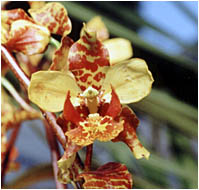 Cyrtopodium gigas (photo:SA) |
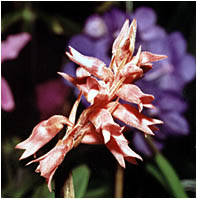 Sacoila lanceolata (photo:SA) |
|
COASTAL SANDBANKS AND SWAMPS AREAS (RESTINGAS, MANGUEZAIS, BREJOS) The occurrence
of orchids in coastal sandbanks
(Restingas) has been the subject of an article Orchid News #14
and of an interview with Cláudio Nicoletti Braga in Orchid News #16. |
| Some
epiphyte can also be found there: Epidendrum anceps (in Pernambuco) and Cattleya intermedia (in south coast of the state of São Paulo). "...At the first sight, the ecosystem is an easy environment to germination and difficult for development... It presents rachitic plants that when transferred to a more appropriate area, grow into normal specimens." (G. J. Pabst e F. Dungs.Orchidaceae Brasilienses). |
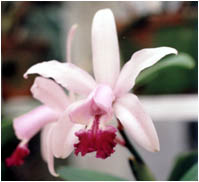 Cattleya intermedia. photo:SA) |
| In
the state of Rio de Janeiro, this is the habitat Oncidium flexuosum
(abundant) and Cattleya harrisoniana. More species: Catasetum macrocarpum, luridum, Cattleya forbesii, harrisoniana, x venosa, Elleanthus linifolius, Habenaria hexaptera, Phgramipedium sargentianum, Rodiguezia obtusifolia, Vanilla schwackeana, between others. The "Brejos" are swamp lowland areas where there are the riverheads or fountainhead ("olhos d'água" it means eyes of water, where the water gushes out) or where the rivers are more or less permanent due to the annual flood (rainy season). They are spread all over the country. In that ecosystem, mainly in the Central Plateau, occur (not necessary |
 Oncidium flexuosum (foto:SA) |
|
associated)
Bletia catenulata (which also occurs in the coastal sandbanks), many
species of Cyrtopodium such as hatschbachii, paludicolum, parviflorum,
Galeandra juncea, Eulophia, Sarcogltottis uiliginosa, Pteroglossa macrantha,
Habenaria, Cleites, Epidendrum dendrobrioides and other species ,
Encyclia, Catasetum, Oncidium hydrophilum, Phragmipedium vitatum, between
others. |
|
Bibliography 1) Astor
Viana Júnior and Pedro Lage Viana, in Cattleya Walkeriana Gardn,
Botanical aspects and Chromatic study Sites
researched : 2) Fundação
SOS Mata Atlântica 3) Brazilian
Ambasse in London.. 4) Manguezal
- Ecologia - Bahiasol.com 5) Brazil
Nature |
| Photographies
by : CE = Carlos Eduardo de Brito Pereira FM = Francisco Miranda SA = Sergio Araujo We would like to thank Carlos Eduardo and, specially, Francisco Miranda for the authorization to use their photos in this article. |
| Any
kind of reproduction (print, digital or anyone other) of any type of
material of this site - texts, lay-out, photos, images and others - is strictly forbidden without the previous written permission of the authors. Any solicitation or information should be done by the e-mail bo@sergioaraujo.com |